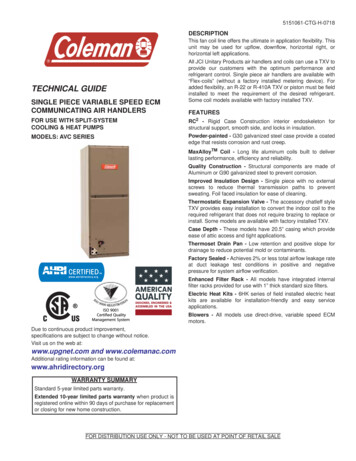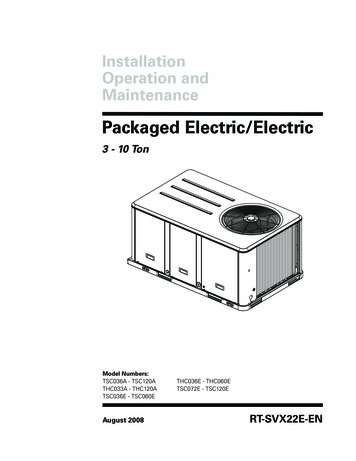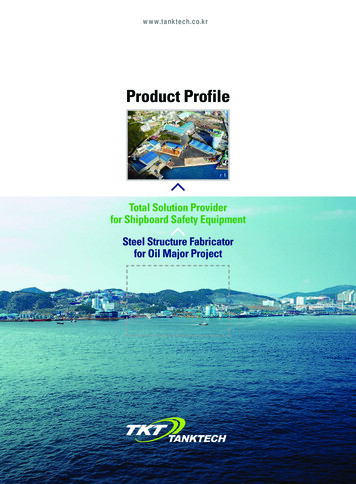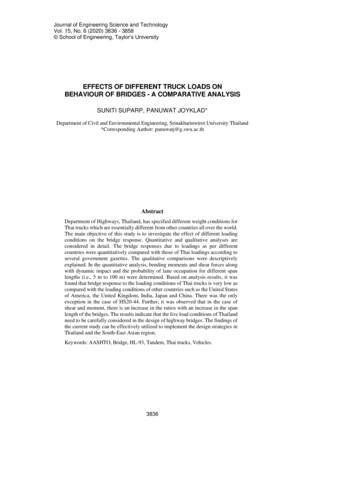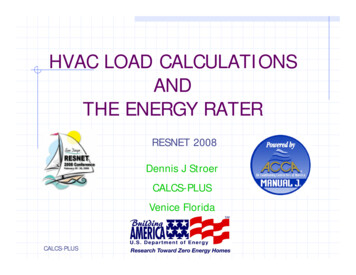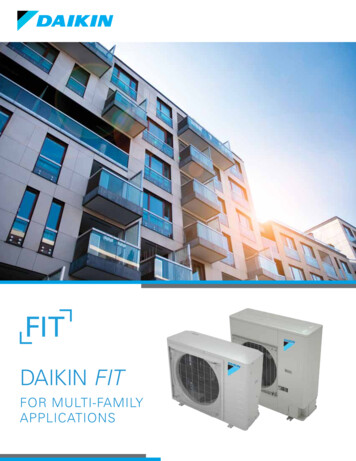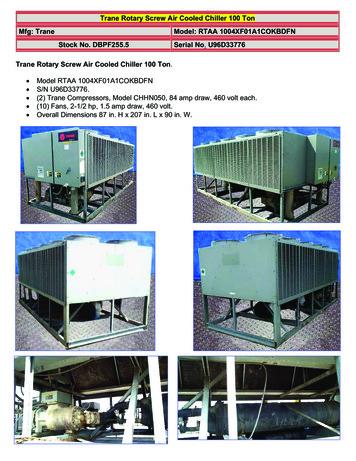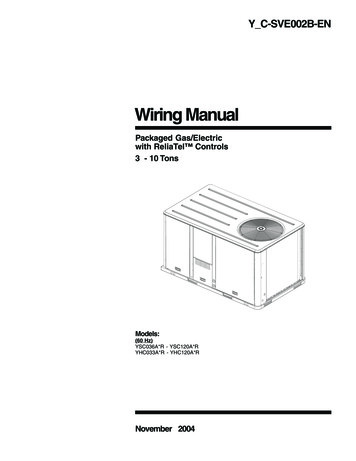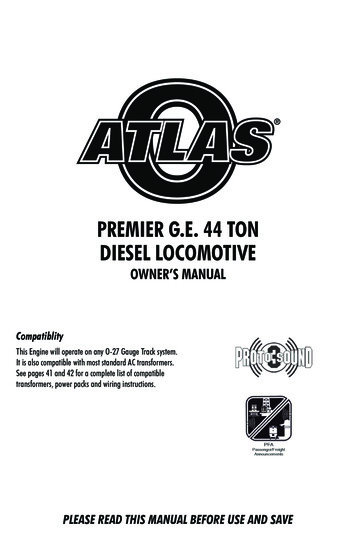
Transcription
PREMIER G.E. 44 TONDIESEL LOCOMOTIVEOWNER’S MANUALCompatiblityThis Engine will operate on any O-27 Gauge Track system.It is also compatible with most standard AC transformers.See pages 41 and 42 for a complete list of compatibletransformers, power packs and wiring instructions.PLEASE READ THIS MANUAL BEFORE USE AND SAVE
Before You BeginTable of ContentsSet Up Checklist. 3Lubrication. 3PS 3.0 EnhancementsConventional AC/DC Start-up/Shut-down. 4LED Lighting. 4DCS/DCC Switch. 5Programming Track (for DCC operation). 5Loading Engine Firmware. 5Modes of OperationConventional AC Operation. 6Conventional DC Operation. 13DCS Operation - Digital Command System. 13DCC - Digital Command Control. 14Proto-Sound 3.0 Expanded DCC Functionality. 23MaintenanceLubricating and Greasing Instructions. 32Cleaning The Wheels, Tires and Track. 33Traction Tire Replacement Instructions. 33Headlight Replacement. 33Troubleshooting Proto-Sound 3.0 Problems. 34Transformer Compatibility and Wiring Chart. 41DC Power Supply Chart. 42Additional Features Accessible Of DCS Remote Control System. 43Atlas O Customer Service. 44CAUTION: ELECTRICALLY OPERATED PRODUCTRecommended for Ages 14 and up. Not recommended for children under 14 years of age without adult supervision. As with all electric products,precautions should be observed during handling and use to prevent electric shock.WARNING: When using electrical products, basic safety precautions should be observed, including the following: Read this manual thoroughly before using this device. Atlas recommends that all users and persons supervising use examine the hobby transformer and other electronic equipment periodically forconditions that may result in the risk of fire, electric shock, or injury to persons, such as damage to the primary cord, plug blades, housing,output jacks or other parts. In the event such conditions exist, the train set should not be used until properly repaired. Do not operate your layout unattended. Obstructed accessories or stalled trains may overheat, resulting in damage to your layout. This train set is intended for indoor use. Do not use if water is present. Serious injury or fatality may result. Do not operate the hobby transformer with damaged cord, plug, switches, buttons or case.This product may be protected by one or more of the following patents: 6,019,289; 6,280,278; 6,281,606; 6,291,263; 6,457,681; 6,491,263;6,604,641; 6,619,594; 6,624,537; 6,655,640. 2021
Before You BeginSet Up Checklist Lubricate Engine Read all General Maintenance and Operation Instructions Apply power to run as described in the Modes of OperationLubricationYou should lubricate the engine to prevent it from squeaking and to prevent excessive wear. Use light household oiland follow the lubrication points marked “L” (shown below). Do not over-oil. Use only a drop or two on each pivotpoint.Lubricate All Wheel Axles (L)Lubricate All Pick Up Roller Axles (L)Atlas Premier G.E. 44 Ton Diesel Engine w/Proto-Sound 3.03
PS 3.0 EnhancementsHere are some of the exciting changes incorporated into your new Atlas Proto-Sound 3.0 Locomotives. Moreadvanced features such as Custom Speed Tables and Advanced Consisting can be found in the DCC section of thismanual.There are 4 options for operating your Atlas Proto-Sound 3.0-equipped engine: Conventional AC Conventional DC DCS - Digital Command System DCC - Digital Command ControlWhen the locomotive is placed on the track and power is applied to the track the locomotive will detect the type ofcontrol system being used and respond accordingly.NOTE: You’ll need to have the DCC/DCS switch set correctly if you’re using one of those two modes.Conventional (Analog) AC/DC Start-up/Shut-downYour new Atlas PS3.0-equipped locomotive no longer has batteries. It uses Super Capacitors to hold the engineboard alive for a short time when you shut off or interrupt track power. Because of this, when you first apply trackpower to your PS3.0-equipped O Gauge engine, you will notice the headlight comes on but nothing else. This isperfectly normal. The capacitors are charging up during this time. The wait time depends upon how long it’s beensince you last applied power to the engine. Typically it will take 1-15 seconds to fully charge. NOTE: The 1-15second charging wait time ONLY applies when using conventional AC track power.Once the headlight shuts off, the engine will play its start-up sounds and all the lights will come back on,simultaneously. Smoke too if you have it turned on.The capacitors hold enough charge to play the full shut-down sounds. Also, the capacitors allow you to operate yourengine in conventional mode just like you would any other conventionally-controlled engine. Finally, because thereare no batteries, you will notice there is no longer an external charge jack on the engine.LED LightingGone are the incandescent bulbs. Your new PS3.0-equipped engine has LED lighting. Atlas uses various colored LEDsto simulate the correct lighting on your engines from the warm, yellow-orange colored light coming out of an oldlantern on your favorite steam engine to the high-intensity halogen lamp on the latest modern diesels, LED’s allowfor various, correct colors. Also, they require less power and do not emit as much heat as incandescent bulbs.Atlas Premier G.E. 44 Ton Diesel Engine w/Proto-Sound 3.04
DCS/DCC SwitchYour Atlas PS3.0-equipped engine has a DCS/DCC selector switch located on the underside of thechassis between the front trucks. To operate theengine in DCS mode, ensure the switch is set toDCS. If you wish to run the engine in DCC mode,ensure the switch is set to DCC.If you inadvertently leave the switch in DCC itwon’t hurt anything, you just won’t be able tocommunicate with your engine with your DCSsystem. Likewise, if you leave the switch in DCSand try to operate the engine under DCC youmay notice a humming coming from your engineand you will likely notice that your DCC system’soverload light will be on.DCS/DCC SwitchProgramming Track (for DCC operation)Your Atlas Proto-Sound 3.0-equipped locomotive does not program well on Programming tracks due to the inclusionof super capacitors utilized in the locomotive’s electronic package. The super capacitors provide backup power tothe electronics, allowing the locomotive to better negotiate track sections suffering from poor electrical conductivity.This ensures that sounds continue to play, the locomotive continues to move forward and lighting remains lit. Duringpower shutdowns, the super capacitors provide power to allow the locomotive shutdown sounds to continue playingthrough their conclusion. Unfortunately, the super capacitors require that operators ONLY program engine CV’s usingProgramming on the Main (PoM).Loading Engine FirmwareYour new Atlas PS3.0-equipped O-Gauge engine affords you the ability to load Engine firmware. Loader version2.30 or later will allow you to do this. Please refer to the Loader program’s instructions for more details. So, as Atlasreleases new features or updates you will be able to take full advantage without having to ship your favorite engineanywhere. All new updates are available on our website. Atlas will make announcements as they are available. Notall updates will apply to all engines.NOTE: Requires a TIU w/version 4.20 or later firmware, and requires Consumer Loader version 2.30 orlater.Atlas Premier G.E. 44 Ton Diesel Engine w/Proto-Sound 3.05
Modes of OperationThe following pages have detailed descriptions of the 4 different modes of operation: Conventional AC Conventional DC DCS - Digital Command System DCC - Digital Command ControlConventional AC OperationWhen using conventional AC power, the engine will respond to changes in track voltage. An increase in track voltagewill increase the locomotive speed and a reduction in track voltage will reduce the engine speed.A short interruption (approximately 1 to 2 seconds) in the track voltage will cause the engine to cycle in the sequencefor each track voltage interruption (neutral – forward – neutral – reverse) When power is first applied to thetrack, the locomotive will be silent for 1-20 seconds and the headlight will be on, indicating the super capacitors arecharging (The super capacitors provide power to the sound system during direction changes or intermittent dropsin track power due to dirty track or on switches, when operating in conventional mode). When the super capacitorsare charged, all the lights will come on and the engine sounds will start up. There should be no movement, as theengine is in neutral. Causing a short interruption of track power by using the direction button on the transformer, orby bringing the throttle to 0 volts and back again, will change the sequence to the forward state. Then increasing thethrottle will begin to move the engine forward, and speed will increase as the throttle is advanced.If there is another interruption in track power the sequence will change to the neutral position again. The enginewill remain in the neutral state until there is another interruption in track power. The next interruption in trackpower will move the sequence to the reverse state. The engine will now move in the reverse direction. If the powerinterruption was accomplished by using the direction button and the throttle position was not changed, the enginewill run in the reverse direction at the same speed that it was traveling in the forward position.Subsequent interruptions in track power of 1-2 seconds will continue the sequence rotation. If you happen tointerrupt track power for longer than about 2 seconds, the engine will begin its shut down sounds. If this occursyou can cycle the direction sequence again to get back to the direction you wish to move and once the engine startsmoving its shut down sounds will stop playing (See direction cycle phases).In conventional AC operation the whistle sound, the bell sound, PFA sounds and other operational functions can beaccessed if your transformer has a horn/whistle button and a bell button. By using combinations of button presses,different commands besides blowing the whistle and ringing the bell can be initiated.Atlas Premier G.E. 44 Ton Diesel Engine w/Proto-Sound 3.06
Proto-Sound 3.0 Conventional AC Operating InstructionsActivating Proto-Sound 3.0 Conventional AC Mode FeaturesThrottle: To increase or decrease track voltage, and therefore train speed, turn the throttle control knob. Turningclockwise will increase voltage and speed, while turning counterclockwise will decrease voltage and speed. Theengine will maintain the speed you set after you release the throttle until you turn it again to change the voltageand speed.Bell: To sound the bell, in an engine equipped with a bell firmly press and release the Bell button. To turn the belloff, press and release the Bell button again. The bell will continue to ring from the time you turn it on until you pressand release the button again to turn it off.Horn/Whistle: To sound the whistle, firmly press the Horn/Whistle button. The whistle will sound for as long as youcontinue to depress the button. It will stop when you release the button.Direction: Your train is programmed to start in neutral. The train will always cycle neutral-forward-neutral-reversewith each press and release of the direction button. The engine is programmed to restart in neutral each time thetrack voltage is turned off for 25 seconds or more.CYCLE PHASESNeutralReverseForwardNeutralAtlas Premier G.E. 44 Ton Diesel Engine w/Proto-Sound 3.07
Manual Volume ControlProto-Sound 3.0 Manual Volume ControlTo adjust the volume of all sounds madeby this engine, turn the manual volumecontrol clockwise to increase the volumeand counterclockwise to reduce thevolume. Turning the manual volumecontrol completely counterclockwise willturn of all of the engine sounds andannouncements.Proto-Sound 3.0 features are activated by sequences of Bell and Horn button pushes described below. Please readthe full descriptions of each feature before using it. To use these buttons to activate features rather than to blow thehorn or ring the bell, you should tap the buttons very quickly with a ½-second pause between button presses. Youmay need to practice your timing to make this work smoothly.Timing ChartPressHornShort &Firm½ Sec.PausePressBellShort &Firm½ Sec.PausePressBellShort &FirmTotal Time Lapse: 1 ½ SecondsFeature to Be ActivatedButton CodeMarker Lights*1 Bell, 1 Horn/WhistlesPFA (Passenger/Freight Announcements)1 Bell, 2 Horn/WhistlesFire the Rear Coupler1 Bell, 3 Horn/WhistlesFire the Front Coupler1 Bell, 4 Horn/WhistlesSpeed Control On/Off1 Horn/Whistle, 2 Bells (from Neutral only)Lock into a Direction1 Horn/Whistle, 3 BellsBeacon Light (On/Off)*1 Horn/Whistle, 4 BellsReset to Factory Defaults1 Horn/Whistle, 5 Bells (from Neutral only)*Only applicable to engines equipped with beacon and/or marker lights. Beacon Lights are also configured to controlWrong Line, Alternate Country and other lighting setups typically found on European models. Marker lights are alsoused as Train/No-Train lighting in European models.Atlas Premier G.E. 44 Ton Diesel Engine w/Proto-Sound 3.08
Marker Lights (On/Off) (if equipped)By default your Marker Lights are set to ON. To toggle the Marker Lights, perform the following sequence on your ACtransformer:PlaceEngine inNeutralBellHornMarker Lights(On/Off)Passenger/Freight Announcements (PFA)Your engine is equipped with a sound package of either passenger station announcements or freight yard soundsthat you can play when you pull into a station or a yard. Each sequence described below will play as long as it isleft on, randomly generating sounds, but be sure to allow approximately 30 seconds between the button pushesdescribed below to allow the PFA sufficient time to run through each sequence. To cue the sound system to play the PFA, quickly but firmly tap the Bell button once followed by 2 quick taps of theHorn button while the engine is moving. Tap the buttons quickly but allow approximately ½ second between eachpress. Press the Direction button once to stop the engine. This will trigger the first sequence of PFA. The reverse unit istemporarily disabled so that the train will not move as you use the Direction button to trigger the sounds. ProtoSound 3.0 has disabled operator control over the Horn and Bell buttons until the full PFA sequence is complete. After waiting about 30 seconds for that sequence to run, press the Direction button again to trigger the secondsequence of PFA. After about 30 seconds, press the Direction button again to trigger the third PFA sequence. Again, after allowing about 30 seconds for that sequence to run, press the Direction button one more time totrigger the fourth and final PFA sequence. The PFA will continue and within a few seconds the bell will beginringing, then the engine will begin moving at the current throttle setting, in the same direction it was travelingwhen you began the sequence. Once the bell turns off, the operator regains control of the transformer’s bell andHorn buttons and can ring the bell or blow the Horn as usual.BellHorn/WhistleHorn/WhistleSound System Cued to PlayFreight Yard or PassengerStation Sounds as Premier G.E. 44 Ton Diesel Engine w/Proto-Sound 3.09OperatorControlsWhen BellTurns Off
Tips on Using PFA You can terminate PFA at any time by turning off power to the track for 15 seconds. You do not have to be in Forward to use PFA. At the conclusion of the full sequence, the train will pull away from thestation or yard in whatever direction you were going when you activated the feature. You can use PFA even if you are double-heading with another engine. If the second engine is not equipped with ProtoSound 3.0, you must remember not to leave the throttle at a high voltage level once you have stopped the engine torun the PFA. Otherwise, the engine without PFA will begin vibrating on the track as its motors strain to move the train,since they cannot be automatically disabled during the PFA cycle (or if an original Proto-Sound engine, PFA aretriggered differently and that engine’s motor-disable feature will not be active when you run PFA in Proto-Sound 3.0). PFA can be triggered from Neutral. It will operate the same as if triggered while in motion except that, at the conclusionof the PFA, the engine will depart in the next direction of travel, as opposed to the direction it was traveling beforeentering Neutral.Proto-Coupler OperationThis locomotive is equipped with one or more coil-wound Proto-Couplers for remote uncoupling action. BecauseProto-Couplers are controlled through the Proto-Sound 3.0 microprocessor, they do not require an uncouplingtrack section or modification to your layout to function. You can fire a coupler from neutral or while in motion. Usethe code shown below to fire the coupler(s).Rear CouplerTo fire the rear coupler, quickly tap the Bell button once followed by three quick taps of the Horn button, allowingapproximately ½ second to lapse between each quick button press. The sound of the liftbar and air line depletionwill play, and the knuckle will be released.BellHornHornHornFireRearCouplerFront CouplerTo fire the front coupler (if your engine has one), quickly tap the Bell button once followed by four quick taps of theHorn button, allowing approximately ½ second to lapse between each quick button press. The sound of the liftbarand air line depletion will play, and the knuckle will be released.BellHornHornHornHornFireFrontCouplerAtlas Premier G.E. 44 Ton Diesel Engine w/Proto-Sound 3.010
Speed ControlAtlas engines equipped with Proto-Sound 3.0 have speed control capabilities that allow the engine to maintain aconstant speed up and down grades and around curves, much like an automobile cruise control. You can add or dropcars on the run, and the engine will maintain the speed you set.While the engine is programmed to start with the speed control feature activated, you can opt to turn it off. Thismeans the engine’s speed will fall as it labors up a hill and increase as it travels downward. It is also affected by theaddition or releasing of cars while on the run. Because the engine will run more slowly at a given throttle voltagewhen speed control is on than when it is off, you should adjust the throttle to a lower power level for operation withspeed control off to avoid high-speed derailments. When speed control is off, the volume will drop to allow for betterlow voltage operation.To turn speed control on and off, put the engine in neutral, then quickly tap the transformer’s Horn button one timethen quickly tap the Bell button two times, allowing approximately ½ second to lapse between each quick buttonpress. Two horn blasts will indicate that the engine has made the change. Repeat the 1 horn, 2 bells code to return itto the other condition. You will want to do this during the initial neutral upon start-up if you ever couple this engineto another engine that is not equipped with speed control to avoid damaging the motors in either engine. Each timeyou shut down the engine completely, it will automatically turn speed control on.PlaceEngine intoNeutralHornBellBellSpeed ControlTwo Horn Blasts(indicates change is made)Repeat to Returnto Normal ConditionLocking Locomotive Into A DirectionYou can lock your engine into a direction (forward, neutral, or reverse) so that it will not change directions. To dothis, put the engine into the direction you want (or into neutral to lock it into neutral), run it at a very slow crawl (asslowly as it will move without halting), and quickly but firmly tap the Horn button once followed by three quick tapsof the Bell button, allowing approximately ½ second to lapse between each quick button press. Two horn blasts willindicate that the engine has made the change. The engine will not change direction (including going into neutral)until you repeat the 1 horn, 3 bells code to return the engine to its normal condition, even if the engine is keptwithout power for extended periods of time.PlaceEngine intoDesiredDirectionHornBellBellBellDirection LockTwo Horn Blasts(indicates change is made)Repeat to Returnto Normal ConditionAtlas Premier G.E. 44 Ton Diesel Engine w/Proto-Sound 3.011
Beacon Light (On/Off) (if equipped)By default your Beacon Light is set to ON. To toggle the Beacon Light, perform the following sequence on your ACtransformer below. NOTE: The Beacon Light is also used to select different lighting schemes primarily inEuropean engines. For example, Wrong Line Operation.PlaceEngine inNeutralHornBellBellBellBeacon Light(On/Off)BellReset to Factory DefaultTo override the settings you currently have assigned to the engine and reset it to its factory defaults, while in Neutraltap the Horn button quickly once, followed by five quick taps of the Bell button, allowing approximately ½ second tolapse between each quick button press. Two horn blasts will indicate that the engine has made the change.PlaceEngine inNeutralHornBellBellBellBellBellResetTwo Horn Blasts(indicates change is made)Repeat to Returnto Normal ConditionAutomatic Sound EffectsCertain Proto-Sound 3.0 sound effects automatically play in programmed conventional mode conditions: Squealing Brakes play any time the engine’s speed decreases rapidly. Cab Chatter plays at random intervals when the engine idles in neutral. Engine Start-up and Shut-down sounds play when the engine is initially powered on or is powered off for fiveseconds or more.Atlas Premier G.E. 44 Ton Diesel Engine w/Proto-Sound 3.012
Conventional DC OperationYour Atlas locomotive will operate on conventional DC track voltage also. However, functions such as sounding thehorn, ringing the bell and the PFA sounds cannot be initiated in conventional DC. Only the engine sounds, smoke,squealing brakes and idle sounds will function.Operation of your Atlas Proto-Sound 3.0 engine in conventional DC is very similar to operating a conventional ACengine. As you increase track voltage, engine speed increases.As the track voltage is decreased, engine speed is decreased. When track voltage polarity is reversed using thepolarity or direction switch on the power pack, the engine will run in the opposite direction. The electronics in yourAtlas Proto-Sound 3.0 locomotive are designed to slowly change direction without a need to change the throttle, ifyou so desire.Just change the polarity switch on your DC power pack and the engine will gradually come to a stop and thenautomatically begin traveling in the opposite direction. The speed will build up to the same speed that the enginewas going in the previous direction. When power is first applied to the locomotive, the engine’s sounds will start upwhen the track voltage reaches about 8 VDC. To get your locomotive moving, after the startup sounds have finishedand the locomotive is idling, slowly increase the track voltage until the locomotive is traveling at the desired speed.NOTE: If you apply more than 9.0VDC to the engine at start-up the engine will not move. This isnormal. We refer to this as “Anti-Jackrabbit” and this feature prevents your model from taking off athigh track voltages. Simply lower the track voltage down below 9.0VDC and then back up to get yourengine moving. This applies only when you start up your engine.DCS - Digital Command SystemWhile the acronyms are close, this is where the similarity ends between DCC and DCS. Yes they are both digitalcontrol systems. However, Atlas DCS is not DCC. There are several proprietary versions of DCC on the market, butDCS is not one of them. Atlas’s DCS System is a proven technology in the O Gauge, One Gauge, and HO Gaugemarkets. First the power signal in DCS is not the command signal. Next DCS employs a fully functional bi-directionalcommunication scheme opening a vast range of advanced features and yet so simple and intuitive that you can enjoythem. No programming tracks, bits and bytes, or conversion of binary to hexadecimal numbers here. To add anengine in DCS, press “ADD ENGINE”. After that, if you want to start your engine just press “START UP” or to turn thesmoke unit on or off, just press “SMOKE”. No combination of letters or numbers to remember.Additional details can be found in the DCS manual that accompanies your DCS system. With DCS, you can have awhole fleet of PS 3.0 engines on the rails and they will remain shut down until you command them to start up.Atlas Premier G.E. 44 Ton Diesel Engine w/Proto-Sound 3.013
DCC - Digital Command ControlDCC is a popular digital command scheme wherein the track power is also a digital control signal. That is, using aDCC controller, you can communicate with multiple engines and have all of them moving at different speeds and invarying directions on the same track at the same time. The power/command signal remains constant and enginesare commanded to perform as desired. Your Atlas PS3.0-equipped engine has the ability to decode and respond tothese DCC commands. This allows you to mix and match Atlas PS3—equipped engines as well as operate them withany other manufacturer’s DCC-decoder equipped engine. The best part about your Atlas PS3.0-equipped engine isthat the decoder is built right in. No need to remove the hood and install speakers or boards. It’s all done for you atthe factory. Each PS3.0-equipped engine has a full complement of lights, sounds, smoke (if equipped). Just set themodel on the rails, apply DCC power and hit F3 on your DCC handheld controller and you’re off and running.Basic DCC OperationYour Atlas PS3.0-equipped engine takes full advantage of DCC’s capabilities. Below are the basic commands you’llwant to know to get started running quickly. Please refer to the Advanced DCC Operation section of the manual ifyou want to dig into the full capability of DCC.Each engine type may have a slightly different F Function list. This depends upon whether it’s steam, diesel, orelectric and whether it has smoke or not. Please refer to the table of Default CV Values for your particular engine’sF Functions. A note about enabling/disabling F Functions in DCC - Depending upon the DCC system you have youmay need to toggle a particular F Function on then off to actually get it to enable. Some DCC systems do this for youautomatically and others allow you to set particular F Function buttons to either be set for momentary or toggle.Please refer to your DCC control station manufacturer’s manual for more information on how they handle F Functionbuttons.Your Atlas PS3.0-equipped engine’s default short address is 3. So all you have to do is power up your DCC systemand call up Locomotive 3 to begin.Start-Up/Shut-DownF3 – Start-Up/Shut-DownPressing this twice (toggle on then off) will start up your engine. When you apply DCC power your Atlas PS3.0equipped engine will remain dark and quiet. Since you likely don’t want to run the engine this way, simply press F3twice to start your engine. The lights, sound and smoke (if equipped) will come on.NOTE: Now your engine will start up just by advancing the throttle. But for the F3 functions (Start Upand Shut Down) to operate, the engine not be moving.To shut your engine down, press the F3 button twice. This will play the shut down sounds and then turn the lightsand smoke and sounds off. As long as there is DCC power still on the track the engine can be started up
Atlas Premier G.E. 44 Ton Diesel Engine w/Proto-Sound 3.0 5 DCS/DCC Switch Your Atlas PS3.0-equipped engine has a DCS/ DCC selector switch located on the underside of the chassis between the front trucks. To operate the engine in DCS mode, ensure the switch is set to DCS. If you wish to run the engine in DCC mode, ensure the switch is set to DCC.
